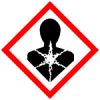Coalition status
Details
GHS safety labels
- H361

Suspected of damaging fertility or the unborn child (state specific effect if known)(state route of exposure if it is conclusively proven that no other routes of exposure cause the hazard)
Class: Toxic to Reproduction - H373

May cause damage to organs (state all organs affected, if known) through prolonged or repeated exposure (state route of exposure if it is conclusively proven that no other routes of exposure cause the hazard)
Class: STOT
Subclass: Repeated exposure - H411

Toxic to aquatic life with long lasting effects
Class: Aquatic
Subclass: Chronic
